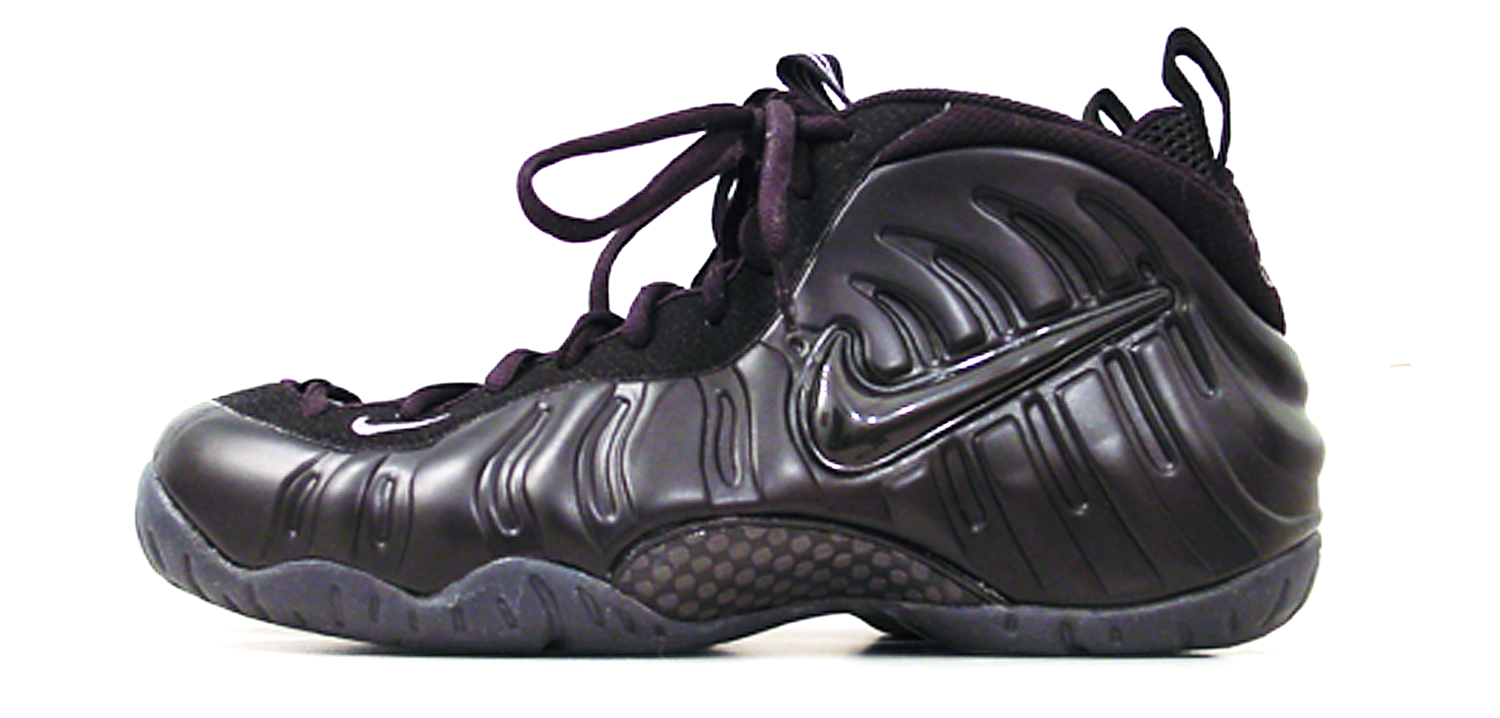The shoe that started the Foamposite revolution has returned, and it’s as futuristic today as it was back in the day.
[Prof’s Note: This review was originally published way back in November of 2000. I’ve resurrected it because the Foamposite Pro and One are dropping in a couple of, er, interesting colorways this month. Check Sneaker News for release dates and pics of the new models.]
Truth be told, back in the day was not all that long ago. The original Foamposite was released in 1997 and a variant of that shoe, the Foamposite One, was Penny Hardaway’s signature shoe in that year.
At the time of its release, the Foam Pro represented the pinnacle of sneaker technology. It incorporated a large, carbon fiber midfoot support plate that wrapped up along both the lateral and medial sides of the foot; a full-length Zoom Air sole unit; and, of course, Nike’s unique Foamposite technology.
figure 1: Pictured at the top of this review is the Nike Air Foamposite One in its iconic dark neon royal colorway; directly above is the Air Foamposite Pro in black/black/grey. The Foam One and Foam Pro are functionally identical, but feature some significant aesthetic differences. Most prominent is that the Foam One lacks the Foam Pro’s honking huge lateral Swoosh. More subtle are the “1 Cent” logos featured on the Foam One’s tongue, heel and outsole—the One features these logos because it was effectively Penny Hardaway’s signature shoe for the ’97 season.
In a nutshell, Foamposite is a composite construction consisting of a thin layer of polyurethane (PU) foam encased within a skin-like outer shell. It’s about as different from conventional shoe construction as a CD is from an 8-track, and the result is a one-piece upper with deeply unique properties. For one thing, unlike more traditional materials like leather or textile, Foamposite doesn’t stretch. It can, however, change shape, and this is what allows Foamposite-based shoes to mold around your foot over time.
If your dogs are wide, the Foam Pros will be uncomfortable to start. But if you can stand the break-in period—which will likely last through multiple wearings—you’ll end up with a shoe that feels like it was poured around each foot. Adding to the comfort factor is a full-length “Dynamic-Fit” innersleeve built into the shoe’s inner. The innersleeve is nearly seamless and provides just the right amount of cush around the foot. The somewhat rigid Foamposite material also means you get plenty of support at the ankle.
figure 2: The Nike Air Foamposite One was an instant classic and the OG remains a grail for many a sneaker fanatic. As you can see above, in addition to its striking dark neon royal hue, a key distinguishing characteristic of the Foam One is its lack of a Swoosh on the lateral quarter panel.
Sandwiched between the upper and the outsole is a full-length Zoom Air unit (something you don’t see much of any more) and a large carbon fiber midfoot support plate. The carbon fiber plate extends further forward towards the forefoot than in most contemporary shoes. I think it’s meant to work in the same way as the Air Jordan XI’s carbon fiber spring plate, making the forefoot of the shoe very stiff. During my test wearings this wasn’t a problem, but with extended wear the stiffness may lead to foot fatigue for some. On the flip side, the combination of a full-length Zoom Air unit and the large carbon fiber plate provides excellent midfoot support—peeps with weak arches will like this shoe a lot.
The carbon fiber plate also helps make the Foam Pro a very stable shoe. This stability, in tandem with the unique properties of the Foamposite upper, come together to make the Foam Pro an awesome shoe for players who do a lot of cutting and slashing to the basket. Because the shoe is so stable and the upper (eventually) molds around your foot, you can make moves without worrying about turning an ankle or beating up your toes. I gave the shoe all I had in terms of cutting and stopping short, and it never disappointed or surprised me. This is a good thing.
figure 3: This shot from behind provides a good look at Penny Hardaway’s fantastic “1 Cent” logo. It may seem like a distant memory today, but there was a time when Penny was seen by many as MJ’s heir apparent. Unfortunately, a string of injuries has prevented Penny from reaching those heights, but he can still deliver flashes of brilliance on-court and in TV spots (this also happens to be my second favorite Nike spot of all time).
The one knock on Foamposite construction, aside from the potentially uncomfortable break-in period, is its weight. And, unfortunately, the Foam Pro doesn’t manage to skirt this: at 19.9 ounces per shoe in a men’s 11, it is a heavy shoe. This, combined with the stiffness at the forefoot, could make it feel clunky and overly restrictive for lighter players.
To sum up, the Foamposite Pro is a blast from the past that’s as great today as it was three years ago. It shows how truly remarkable Nike’s Foamposite technology can be when combined with the right components, but also highlights how little the technology has progressed since its debut. There’s also the issue of price, which is steep. There are better performance options to be had for less money, but if you’re a sucker for tech or are a bigger guard or forward who loves to cut and slash to the basket, the Foam Pro is still like nothing else on the market.
Who’s Worn It
Penny Hardaway (G- then with the Orlando Magic); Mike Bibby (G- then with the University of Arizona Wildcats)





